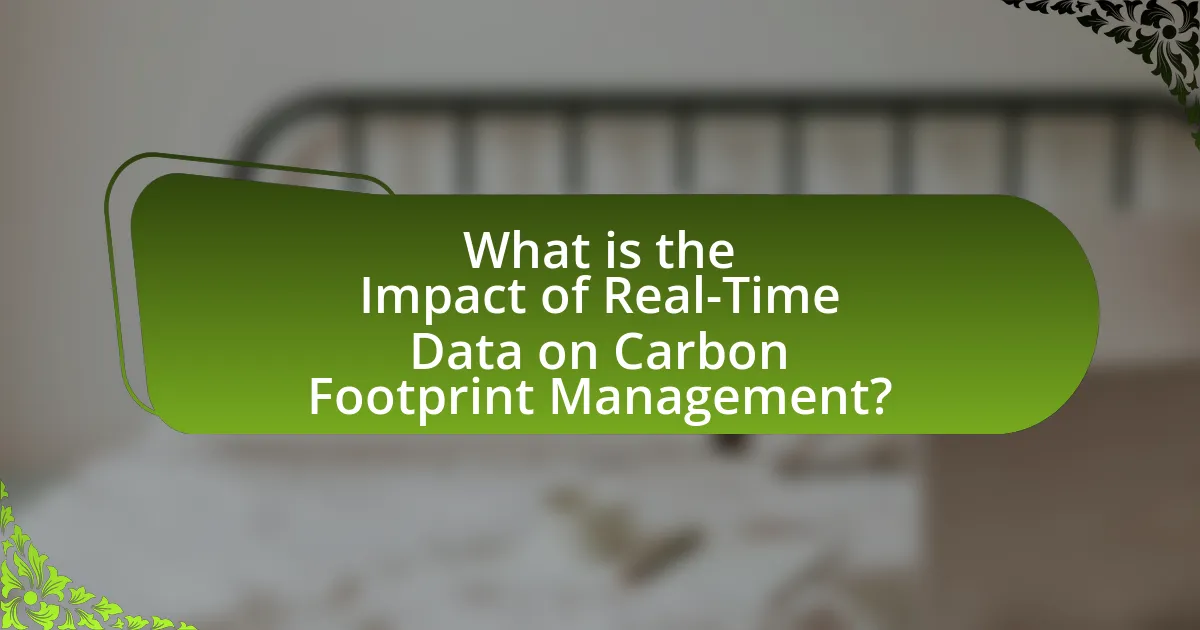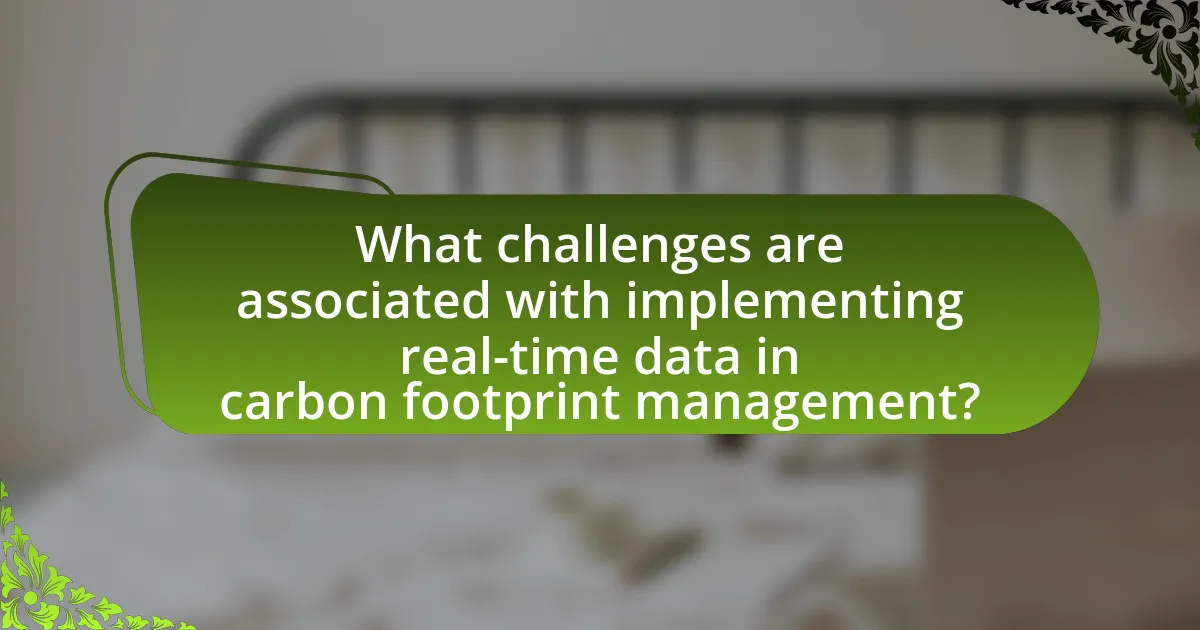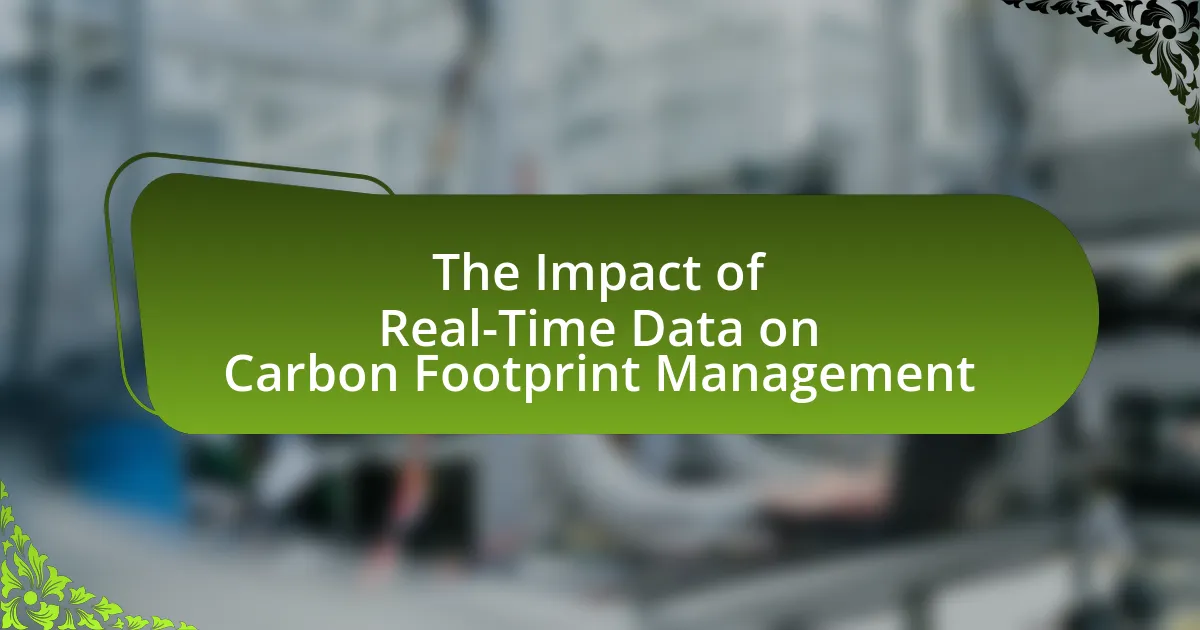The article focuses on the impact of real-time data on carbon footprint management, highlighting its role in enabling organizations to continuously monitor emissions and make informed decisions. It discusses how real-time data enhances carbon footprint tracking, improves accuracy in assessments, and facilitates timely decision-making through technologies such as IoT devices and data analytics. Additionally, the article addresses the challenges organizations face when implementing real-time data solutions, including data integration, accuracy, and cost, while also exploring future trends and best practices for effective utilization of real-time data in sustainability efforts.

What is the Impact of Real-Time Data on Carbon Footprint Management?
Real-time data significantly enhances carbon footprint management by enabling organizations to monitor emissions continuously and make informed decisions promptly. This immediacy allows for the identification of inefficiencies and the implementation of corrective actions in real-time, leading to reduced emissions. For instance, a study by the Carbon Trust found that companies utilizing real-time data analytics can reduce their carbon emissions by up to 20% within the first year of implementation. By leveraging technologies such as IoT sensors and data analytics platforms, businesses can track energy consumption and emissions across various operations, facilitating targeted strategies for carbon reduction.
How does real-time data influence carbon footprint tracking?
Real-time data significantly enhances carbon footprint tracking by providing immediate insights into emissions levels and resource usage. This immediacy allows organizations to make timely adjustments to their operations, thereby reducing their carbon output effectively. For instance, a study by the Carbon Trust found that companies utilizing real-time monitoring systems could reduce their carbon emissions by up to 20% within the first year of implementation. By continuously analyzing data from various sources, such as energy consumption and transportation logistics, businesses can identify inefficiencies and implement corrective measures swiftly, leading to more accurate and actionable carbon footprint assessments.
What technologies enable real-time data collection for carbon management?
Technologies that enable real-time data collection for carbon management include Internet of Things (IoT) devices, satellite remote sensing, and blockchain technology. IoT devices, such as sensors and smart meters, continuously monitor emissions and energy usage, providing immediate data for analysis. Satellite remote sensing offers comprehensive environmental monitoring, capturing data on greenhouse gas concentrations and land use changes in real time. Blockchain technology enhances data integrity and transparency by securely recording carbon credits and emissions data, facilitating trust among stakeholders. These technologies collectively support effective carbon management strategies by delivering timely and accurate information.
How does real-time data improve accuracy in carbon footprint assessments?
Real-time data enhances accuracy in carbon footprint assessments by providing immediate and precise measurements of emissions sources. This immediacy allows organizations to capture fluctuations in energy use, transportation, and production processes as they occur, rather than relying on outdated or estimated data. For instance, a study by the Carbon Trust found that real-time monitoring can reduce emissions reporting errors by up to 30%, as it enables timely adjustments and more accurate calculations based on actual usage patterns. Consequently, the integration of real-time data leads to more reliable assessments, facilitating better decision-making and targeted interventions in carbon management strategies.
Why is real-time data essential for effective carbon footprint management?
Real-time data is essential for effective carbon footprint management because it enables organizations to monitor emissions continuously and make immediate adjustments. This immediacy allows for timely decision-making, ensuring that carbon reduction strategies are implemented as soon as inefficiencies are identified. For instance, a study by the Carbon Trust found that companies using real-time monitoring systems reduced their carbon emissions by up to 20% within the first year of implementation. By leveraging real-time data, organizations can optimize energy usage, track progress against targets, and respond swiftly to changes in operational conditions, ultimately leading to more effective carbon management.
What are the key benefits of using real-time data in sustainability efforts?
The key benefits of using real-time data in sustainability efforts include enhanced decision-making, improved resource efficiency, and increased transparency. Real-time data allows organizations to monitor environmental impacts instantly, enabling timely adjustments to reduce carbon footprints. For instance, a study by the World Resources Institute found that companies utilizing real-time data analytics can reduce energy consumption by up to 20%, demonstrating significant resource efficiency. Additionally, real-time data fosters transparency by providing stakeholders with immediate access to sustainability metrics, which can enhance accountability and trust.
How does real-time data facilitate timely decision-making in carbon management?
Real-time data facilitates timely decision-making in carbon management by providing immediate insights into emissions levels and operational efficiencies. This immediacy allows organizations to quickly identify areas for improvement, enabling them to implement corrective actions that reduce carbon footprints effectively. For instance, a study by the Carbon Trust found that companies utilizing real-time monitoring systems reduced their carbon emissions by up to 20% within the first year of implementation. By leveraging real-time data, decision-makers can respond to fluctuations in energy use or emissions, optimizing processes and enhancing sustainability efforts.

What challenges are associated with implementing real-time data in carbon footprint management?
Implementing real-time data in carbon footprint management presents several challenges, including data integration, accuracy, and cost. Data integration issues arise from the need to consolidate information from various sources, such as sensors, IoT devices, and existing databases, which can lead to inconsistencies. Accuracy is a critical challenge, as real-time data must be reliable to inform decision-making; inaccuracies can stem from sensor malfunctions or data transmission errors. Additionally, the cost of deploying and maintaining the necessary technology infrastructure can be prohibitive, particularly for smaller organizations. These challenges must be addressed to effectively leverage real-time data for carbon footprint management.
What are the common obstacles organizations face when adopting real-time data solutions?
Organizations commonly face several obstacles when adopting real-time data solutions, including data integration challenges, high implementation costs, and a lack of skilled personnel. Data integration challenges arise from the need to consolidate information from various sources, which can be complex and time-consuming. High implementation costs can deter organizations, as investing in new technologies and infrastructure requires significant financial resources. Additionally, the lack of skilled personnel limits the ability to effectively utilize real-time data solutions, as organizations may struggle to find employees with the necessary expertise in data analytics and technology. These obstacles can hinder the successful implementation of real-time data solutions, impacting overall efficiency and decision-making processes.
How can data privacy concerns impact the use of real-time data?
Data privacy concerns can significantly restrict the use of real-time data by imposing regulations and limitations on data collection and sharing practices. For instance, laws such as the General Data Protection Regulation (GDPR) in Europe mandate strict consent requirements and transparency, which can hinder organizations from utilizing real-time data for carbon footprint management. These regulations often lead to increased compliance costs and the need for robust data governance frameworks, ultimately limiting the availability and effectiveness of real-time data analytics. Consequently, organizations may face challenges in optimizing their carbon footprint strategies due to restricted access to timely and relevant data.
What technical limitations might hinder the effectiveness of real-time data?
Technical limitations that might hinder the effectiveness of real-time data include issues such as data latency, bandwidth constraints, and integration challenges. Data latency can result in delays between data collection and analysis, which diminishes the timeliness of insights needed for effective decision-making. Bandwidth constraints can limit the volume of data transmitted, affecting the ability to process large datasets in real-time. Integration challenges arise when disparate systems and data sources do not communicate effectively, leading to incomplete or inaccurate data. These limitations can significantly impact the ability to manage carbon footprints effectively, as timely and accurate data is crucial for monitoring and reducing emissions.
How can organizations overcome these challenges?
Organizations can overcome challenges in carbon footprint management by implementing advanced data analytics and real-time monitoring systems. These technologies enable organizations to track emissions more accurately and make informed decisions based on current data. For instance, a study by the Carbon Trust found that companies using real-time data analytics can reduce their carbon emissions by up to 20% within a year. Additionally, fostering a culture of sustainability and training employees on data utilization can enhance engagement and compliance with carbon reduction strategies.
What strategies can be employed to enhance data integration for carbon management?
To enhance data integration for carbon management, organizations can implement standardized data formats and protocols to ensure compatibility across various systems. This approach facilitates seamless data exchange and aggregation from diverse sources, such as IoT devices, emissions tracking software, and supply chain management systems. For instance, the use of the Greenhouse Gas Protocol provides a framework for consistent reporting and accounting of greenhouse gas emissions, which aids in data integration efforts. Additionally, employing cloud-based platforms can centralize data storage and enable real-time analytics, allowing for timely decision-making and improved carbon management strategies.
How can organizations ensure data security while utilizing real-time data?
Organizations can ensure data security while utilizing real-time data by implementing robust encryption protocols and access controls. Encryption protects data in transit and at rest, making it unreadable to unauthorized users. Access controls, such as role-based permissions, limit data access to only those individuals who require it for their tasks, thereby reducing the risk of data breaches. According to a report by the Ponemon Institute, organizations that employ encryption experience 50% fewer data breaches compared to those that do not. Additionally, regular security audits and compliance with standards like GDPR and ISO 27001 further enhance data security measures, ensuring that real-time data usage aligns with best practices in data protection.

What are the future trends in real-time data and carbon footprint management?
Future trends in real-time data and carbon footprint management include the integration of advanced analytics, artificial intelligence, and IoT technologies to enhance data accuracy and responsiveness. These technologies enable organizations to monitor emissions in real-time, allowing for immediate adjustments to operations that can reduce carbon footprints. For instance, a report by the International Energy Agency indicates that real-time monitoring can lead to a 10-20% reduction in energy consumption in industrial settings. Additionally, the rise of blockchain technology is expected to improve transparency and traceability in carbon accounting, facilitating more reliable carbon credit trading. As businesses increasingly prioritize sustainability, the demand for real-time data solutions will likely grow, driving innovation and investment in this sector.
How is technology evolving to support real-time data in sustainability?
Technology is evolving to support real-time data in sustainability through advancements in IoT, big data analytics, and cloud computing. IoT devices, such as smart sensors, collect environmental data continuously, enabling organizations to monitor resource usage and emissions in real-time. Big data analytics processes this vast amount of data, providing actionable insights that help in making informed decisions for reducing carbon footprints. Cloud computing facilitates the storage and sharing of this data across platforms, allowing for collaborative efforts in sustainability initiatives. For instance, a study by the International Energy Agency in 2021 highlighted that real-time data analytics can improve energy efficiency by up to 30%, demonstrating the tangible benefits of these technological advancements in sustainability efforts.
What role will artificial intelligence play in carbon footprint management?
Artificial intelligence will play a crucial role in carbon footprint management by enabling real-time data analysis and predictive modeling. AI algorithms can process vast amounts of environmental data to identify patterns and optimize resource usage, leading to reduced emissions. For instance, a study by the International Energy Agency found that AI applications in energy management could reduce global CO2 emissions by up to 4 gigatons annually by 2030. This demonstrates AI’s potential to enhance efficiency in energy consumption and support decision-making processes aimed at sustainability.
How might regulatory changes influence the use of real-time data?
Regulatory changes can significantly enhance the use of real-time data by mandating transparency and accountability in carbon emissions reporting. For instance, regulations such as the European Union’s Green Deal require companies to monitor and report their carbon footprints in real time, thereby incentivizing the adoption of advanced data analytics technologies. This shift not only promotes compliance but also encourages organizations to leverage real-time data for more effective carbon management strategies, ultimately leading to reduced emissions and improved sustainability practices.
What best practices should organizations follow for effective real-time data utilization?
Organizations should implement a robust data governance framework to ensure effective real-time data utilization. This framework includes establishing clear data ownership, maintaining data quality, and ensuring compliance with regulations. For instance, a study by Gartner highlights that organizations with strong data governance are 2.5 times more likely to make data-driven decisions. Additionally, integrating advanced analytics tools enables organizations to derive actionable insights from real-time data, enhancing decision-making processes. According to McKinsey, companies that leverage real-time analytics can improve operational efficiency by up to 20%. Furthermore, fostering a culture of data literacy among employees empowers them to utilize data effectively, leading to better outcomes in carbon footprint management.
How can organizations establish a culture of data-driven decision-making?
Organizations can establish a culture of data-driven decision-making by integrating data analytics into their core processes and promoting data literacy among employees. This involves providing access to relevant data tools and resources, ensuring that all levels of staff understand how to interpret and utilize data effectively. Research indicates that companies with a strong data culture are 5-6 times more likely to make faster decisions than their competitors, highlighting the importance of fostering an environment where data is valued and utilized in everyday operations. Additionally, leadership must model data-driven behaviors, encouraging teams to rely on data insights for strategic planning and operational improvements.
What metrics should be prioritized for monitoring carbon footprints in real-time?
The metrics that should be prioritized for monitoring carbon footprints in real-time include greenhouse gas emissions (GHG), energy consumption, and waste generation. Greenhouse gas emissions, measured in CO2 equivalents, provide a direct indication of the carbon footprint associated with various activities. Energy consumption metrics, such as kilowatt-hours used, help assess the efficiency of energy use and its impact on emissions. Waste generation metrics, including the volume and type of waste produced, are crucial for understanding the lifecycle emissions associated with products and services. These metrics are essential for organizations aiming to reduce their carbon footprint effectively, as they enable timely adjustments and informed decision-making based on real-time data.

